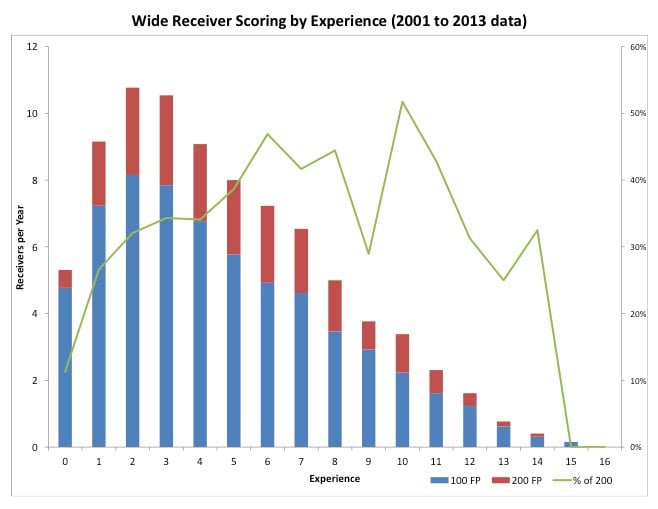Dynasty WR Deep Dive: Setting the Bar

The series continues with a look at wide receivers, a position that has benefited from the NFL’s offensive evolution over the last ten years. It was once taboo to consider a wide receiver in the first round of redraft leagues, now there are even proponents of the “zero running back strategy” that specifically focuses on early round receivers. As for dynasty and keeper leagues, many leagues have taken to larger starting lineups to feature more pass catchers and owners have increasingly filled their rosters with slot receivers and limited vertical threats. As always, this piece will dive into the lifecycle of a wide receiver to understand their career progression.
A note before we get into the data: I am a proponent of PPR, so all data will be evaluated using standard PPR settings. For those of you in ½ PPR or no PPR leagues, much of the directional data will still apply.
Setting the Bar: Lifecycle
Unsurprisingly, wide receivers have a progression that more closely mirrors the quarterback position as opposed to running backs.
[am4show have=’p2;p3;p4;p5;p6;’ guest_error=’sub_message’ user_error=’sub_message’ ]

Diving further into the lifecycle, the “Early Career” phase gives way to the “Near Prime” phase that shows an average jump of 27% in performance by wide receivers. The year two to year three jump is a more modest 16% (from 8.4 to 9.7 fantasy points per game) but shows the development occurs over the shorter timeframe. Another interesting note is that of the seasons where a receiver has been able to average 20 fantasy points per game (there have been 25 between 2001 and 2013), 14 have occurred in the “Near Prime” phase. This may be a coincidence, but more likely, this is an indication of the potential that exists during this timeframe.
The “Prime” phase is the largest time period that goes from year six to ten for a wide receiver. What is interesting is that while upwards to 90% of wide receivers who have accumulated stats in the “Early Career” phase last until the “Prime” phase, less than 30% of those players make it to the “Post-Prime” phase. This means that while the “Prime” phase can be lucrative for an owner with a top wide receiver, this is also the timeframe when you are most likely to see your player end his career.
The “Post-Prime” phase starts seeing an annual decrease in scoring as well as a precipitous drop in population. If you are fortunate enough to have a player make it to this point in their career, sell that stock while you can. The “End of Career” phase is very sparsely populated with mostly Hall of Fame type receivers so there is little to say here other than good job on owning a truly transcendent receiver.
When digging deeper into receivers who surpass the 200 point (roughly 20 to 24 annually) and 100 point (over 60), we see the previous point regarding wide receiver longevity play out further. The sheer volume of 100 and 200 point scorers favors younger players as we see an average of over 10 players reach the threshold annually. However, there is a higher ratio of players reaching the 200 point threshold, relative to 100 point players, during the “Prime” phase.

What this all tells us is that for those who make it to their “Prime” phase, the payoff is big. It also means that younger players are being utilized more by NFL teams so they shouldn’t be ignored. Just don’t expect large contributions in the first two years, the numbers show that’s highly unlikely.
Stay tuned for Part two which will delve into some of the rules we will create based upon benchmarks at the wide receiver position. Also, Part three will apply what we have learned to evaluate some rookies and players of interest.
Feel free to reach out in the comments below or on Twitter @Rotohack
[/am4show]
- Bowl Game Previews: CFB Playoff Semifinals - December 28, 2018
- The Narrative Fallacy and How it Compels Us - May 13, 2017
- 2017 NFL Draft – College Wide Receiver AIR - April 27, 2017

































































